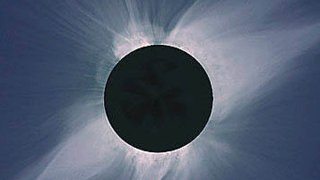
Although much of the country will be able to see bits and pieces of the upcoming total solar eclipse on April 8, certain locations will be directly in its "path of totality" -- including Summit County, Ohio.
"We have the front-row seat of how it comes through Ohio," Dr. Allen Turner, Emergency Management Specialist for the NASA Glenn Research Center said during a virtual meeting earlier this month with officials from the county. "It's going to be in the southern western area of Ohio, and the path is going to be coming up through the west, through Lorain County, Erie County, in that area, just west of Cleveland."
According to the latest Census data, the population of Summit County, Ohio was approximately 540,428 people. That number is expected to "significantly" increase April 8, officials said, as dozens of visitors are expected to join in on grabbing a front-row seat when the total solar eclipse passes through, at around 2:15 p.m. CT.
"We're going to make sure that they are all aware and prepared and ready have enough resources on hand to be able to deal with the visitors and guests and travelers that may want to come to Northeast Ohio," Summit County Emergency Management Agency Director Thomas Smoot said. "A number of our counties and contiguous counties will be impacted and there's a number of events and that will be taking place. So we want to make sure that everyone has a safe viewing experience."
We're making it easier for you to find stories that matter with our new newsletter — The 4Front. Sign up here and get news that is important for you to your inbox.
Greta Johnson, Assistant Chief of Staff and Director of Communications at Summit County Executive noted that friendly Ohioans may be apt to let visitors park on their lawn, but warned that this could lead to traffic, congestion, and unforeseen homeowner headaches.
"With increased traffic becomes increased traffic accidents and congestion and we worry about pedestrian safety as well," Johnson said. "You might be nice to your neighbors, or really try to let folks ark on your lawn. You have to be very careful if you have a septic or well where you let people park in your yard. You could unintentionally crush your septic system."
Johnson went on to say that traffic congestion photos from the last solar eclipse, which took place in 2017 and could be seen over Kentucky or Tennessee, looked like "mayhem."
U.S. & World
The day's top national and international news.
"We're telling everyone, 'stay home,' Johnson said. "Watch the clips at home, and let your guests sleep on the couch." But make sure that you just keep everyone safe ... make sure you have a full tank of gas before you get to wherever you're arriving for the Eclipse. Make sure you have water in your car in case you get stuck and you have to stay."
Officials also warned residents that an influx of people using their phones at the same time could even impact cell reception -- similar to what often occurs at a large event, like a concert.
"I think the natural tendency, when we see an event like this is to livestream and pull your phone out when its toward the Eclipse, but that's going to take bandwidth," Smoot said. "And we only have a limited amount of bandwidth of cellular data. And once that's gone, there is no more bandwidth to make phone calls or things like that."
When does the total eclipse begin?
Around 12:30 p.m. on April 8, the eclipse enter the country and begin moving into Southwest Texas.
By 1:30 p.m., it will move into the Dallas area, NBC 5 Meteorologist Kevin Jeanes said.
"It's going to move slowly to begin with, and the shadow will pick up some forward speed," Jeanes said.
Where is the "path of totality?"
The eclipse's "path of totality" will start in Southwest Texas and move northeast.
The path of totality includes the southern tip of Illinois, central and southern Indiana and Indianapolis. From there, it will race across Cleveland, Ohio; Buffalo, New York and into Maine.
The below map from the Adler Planetarium shows what the eclipse will look like in Illinois, with Carbondale, Mount Vernon, Metropolis and Mount Carmel among the southern Illinois cities in the path of totality.
Will it be visible from Chicago?
According to Jeanes, the eclipse will be "visible in some way from across the country."
From Chicago, parts of it will begin at 12:51 p.m., Jeanes said. The peak time to see it here will be around 2:07 p.m., Jeanes added.
By 3:22 p.m., it will move out of the area.
Will I need glasses?
Yes.
"You must have glasses from Chicago, or you can make a pin hole box to view it," Jeanes said. That's because it's not safe to look at from a vantage point outside the path of totality.
"We cannot look at the sun when not its the total eclipse," Jeanes stressed.
An article from Travel + Leisure magazine agrees, citing the American Astronomical Society.
"The American Astronomical Society recommends you wear solar eclipse glasses at all times while viewing a solar eclipse," the article said. "If you are not in the path of totality, you will only ever see the partial eclipse, so it's crucial you keep your eclipse sunglasses on at all times to avoid eye damage."
According to the Adler Planetarium, viewing the solar eclipse without glasses can result in irreversible eye damage within seconds, and as your eyes lack the nerve endings to register pain as it's occurring, it'll be too late by the time you know.
When is the next time a total solar eclipse will occur?
The next total solar eclipse in the United States is set to place Aug. 12, 2045.
The next total solar eclipse with Chicago in a path of totality isn't until Aug. 4, 2111, Jeanes said.



